routing 最短路径算法分析
邮递员问题最短路径的解法

邮递员问题最短路径的解法邮递员问题,又称旅行商问题(Traveling Salesman Problem,TSP),是一个著名的组合优化问题。
它要求找到一条路径,使得邮递员从出发点出发,经过所有的城市且仅经过一次,最后回到出发点,同时路径长度最短。
由于邮递员问题是NP-hard问题,没有多项式时间的解法。
然而,存在一些启发式和近似算法可以在可接受的时间内找到较好的解决方案:1. 蛮力法:尝试所有可能的路径组合,计算每条路径的长度,最终选择最短路径作为解。
这种方法的时间复杂度为O(n!),适用于较小规模的问题。
2. 最近邻算法:从一个起始点开始,每次选择离当前点最近的未访问过的城市作为下一个访问点,直到所有城市都被访问过,然后回到起始点。
该算法的时间复杂度为O(n^2),虽然不能保证找到最优解,但是可以在较短的时间内找到较好的解。
3. 2-opt算法:先使用最近邻算法得到一个初始解,然后对路径进行优化。
2-opt算法通过不断交换路径中的两个边来减小路径的长度,直到没有可改进的交换。
该算法可以较快地优化路径,但无法保证找到全局最优解。
4. 遗传算法:使用进化计算的思想来解决TSP问题。
通过生成初始种群,交叉、变异等操作进行迭代优化,逐渐找到更好的路径。
遗传算法可以在较短时间内找到较好的解,但是无法保证找到最优解。
上述算法只是解决TSP问题的一部分方法,具体使用哪种方法取决于问题规模和时间要求。
对于较小规模的问题,可以使用蛮力法或者最近邻算法得到较好的解。
对于更大规模的问题,可以考虑使用启发式算法,如遗传算法等。
此外,还存在其他算法和优化技术用于处理TSP问题,根据具体情况选择合适的方法。
计算机网络网络层路由算法
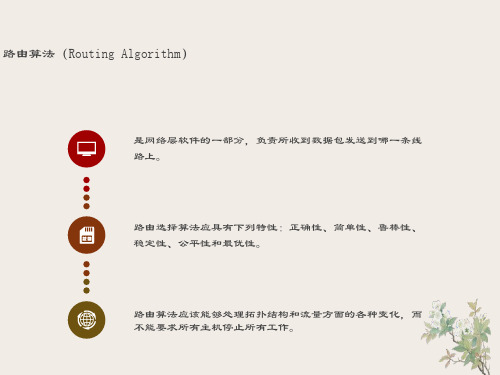
链路状态包
分发链路状态数据包
泛洪法:为了控制泛洪规模,每个数据包包含一个序号,序号随着每个数据包发出逐一递增,路由器记录下它所看到的所有(源路由器,序号)对,当一个新的链路状态数据包到达时,路由器检查这个数据包是否已经出现在上述观察到的列表中,若是新的数据包,则转发,若重复或过时则丢弃。
交换距离信息更新路由表示例
无穷计算问题
∞ 第1次交换后
∞ 第3次交换后
A
B
C
D
E
1
2
3
4 初始时
3
2
3
4 第1次交换后
3
4
3
4 第2次交换后
5
4
5
4 第3次交换后
5
6
5
6 第4次交换后
7
6
7
6 第5次交换后
7
8
7
8 第6次交换后
∞
∞
∞
∞
(b)
.
.
.
A
B
C
D
E
∞
∞
∞
∞ 初始时
1
路由算法(Routing Algorithm)
是网络层软件的一部分,负责所收到数据包发送到哪一条线路上。
路由选择算法应具有下列特性:正确性、简单性、鲁棒性、稳定性、公平性和最优性。
路由算法应该能够处理拓扑结构和流量方面的各种变化,而不能要求所有主机停止所有工作。
路由选择算法可以分为两大类:
01
∞
∞
1
2
∞
∞ 第2次交换后
1
2
3
1
2
3
4 第4次交换后
(a)
最短路径路由算法

最短路径路由算法1. 引言最短路径路由算法是计算机网络中的一种重要算法,用于确定网络中两个节点之间的最短路径。
在网络通信中,选择最短路径可以大大提高数据传输的效率和可靠性。
本文将介绍最短路径路由算法的原理、常见算法以及应用领域。
2. 原理概述最短路径路由算法是基于图论的算法。
它将网络抽象成一个有向图,其中节点表示网络中的路由器或交换机,边表示节点之间的连接。
每条边都有一个与之相关的权重,表示在该路径上传输数据的代价。
最短路径路由算法的目标是找到网络中两个节点之间的最短路径,即路径上的所有边的权重之和最小。
3. 常见算法3.1 Dijkstra算法Dijkstra算法是最短路径路由算法中最经典的算法之一。
它通过逐步确定从源节点到其他节点的最短路径来实现最短路径的计算。
算法的核心思想是维护一个距离表,记录从源节点到其他节点的当前最短距离。
通过不断更新距离表中的值,最终得到源节点到目标节点的最短路径。
3.2 Bellman-Ford算法Bellman-Ford算法是另一种常见的最短路径路由算法。
与Dijkstra 算法不同,Bellman-Ford算法可以处理带有负权边的图。
算法通过进行多次迭代,逐步更新节点之间的最短距离,直到收敛为止。
Bellman-Ford算法的优势在于可以处理具有负权边的情况,但由于需要进行多次迭代,算法的时间复杂度较高。
3.3 Floyd-Warshall算法Floyd-Warshall算法是一种全局最短路径算法,用于计算图中任意两个节点之间的最短路径。
算法通过动态规划的方式,逐步更新节点之间的最短距离。
Floyd-Warshall算法的时间复杂度较高,但由于可以同时计算所有节点之间的最短路径,因此在网络规模较小的情况下,仍然是一个有效的算法。
4. 应用领域最短路径路由算法在计算机网络中有广泛的应用。
其中,最为典型的应用之一就是Internet路由器的路由选择。
Internet由大量的路由器组成,路由器之间的通信需要选择最短路径,以保证数据的快速传输和网络的稳定性。
最短路径算法分析2

随着计算机和地理信息科学的发展,地理信息系统因其强大的功能得到日益广泛和深入的应用。
网络分析作为GIS最主要的功能之一,在电子导航、交通旅游、城市规划以及电力、通讯等各种管网、管线的布局设计中发挥了重要的作用,通用的网络分析功能包括路径分析、资源分配、连通分析、流分析等。
网络分析中最基本和最关键的问题是最短路径问题,它作为许多领域中选择最优问题的基础,在交通网络分析系统中占有重要地位。
从道路网络模型的角度看,最短路径分析就是在指定道路网络的两节点间找出一条阻碍强度最小的路径。
根据阻碍强度的不同定义,最短路径不仅仅指一般地理意义上的距离最短,还可以引申到其它的度量,如时间、费用、线路容量等。
相应地,最短路径问题就成为最快路径问题、最低费用问题等。
因此,城市道路网作为一种大型网络设施有其本身的特征。
它一方面包含网络本身的拓扑特征;另一方面还包含了大量反应地理位置特征的几何数据。
本文根据道路网的特点,运用GIS网络分析功能对道路网络模型、道路的权重选择以及快速寻求路网中两节点间的最短路径算法分别进行了研究。
1 道路网模型及权重设置1.1 道路网模型建立城市道路网主要由众多道路相交、相连构成。
在纵横交织、错综复杂的道路网络中,道路间的地理位置关系相当复杂,一条道路可能与若干条道路相交相连,且其相交相连的模式复杂。
为了避免过多地考虑道路间的拓扑关系,抽取道路网中道路交叉路口作为分析对象,并对道路以交叉路口为结点进行分割,成为路段。
这样,整个网络图将由交叉路口点和路段组成,并定义交叉路口点为网络的结点,路段为网络的弧。
从而建立基于路段连接的网络模型,其模型形式表述为:式中,RW代表道路网络;N代表结点集;R代表路段集合,其元素为有序对,表示由结点x到结点y存在一条有向通路;LR代表路段长度集合,其元素表示有向路段的加权长度。
其中,路段的加权长度是指根据目标函数要求,综合各种动态实时信息和静态属性信息后所得的路段参数,而并非真实意义下的长度。
最短路径算法在网络路由中的应用

最短路径算法在网络路由中的应用网络路由是指在计算机网络中,确定从源节点到目标节点的最优路径的过程。
在网络通信中,如何快速准确地选择最短路径显得尤为重要。
最短路径算法作为一种重要的数学工具,被广泛应用于网络路由中。
本文将介绍最短路径算法在网络路由中的应用。
一、最短路径算法概述最短路径算法,顾名思义,是一种用于计算图中从起点到终点的最短路径的算法。
在网络路由中,图的顶点代表网络节点,图的边代表网络链接,边的权重代表路径的距离或成本。
最短路径算法通过计算路径的距离或成本,来选择出从源节点到目标节点的最优路径。
二、Dijkstra算法Dijkstra算法是一种常用的最短路径算法。
该算法以源节点为起点,逐渐扩展路径,直到找到目标节点的最短路径。
Dijkstra算法使用一个优先队列来存储尚未访问的节点,并通过不断更新节点的距离值来选择最短路径。
该算法的时间复杂度为O((V+E)logV),其中V为节点数量,E为边数量。
Dijkstra算法在网络路由中的应用广泛。
路由器通过使用Dijkstra算法,能够快速计算出从本地节点到目标节点的最短路径,并将数据包发送至该路径上的下一跳节点。
该算法能够保证网络通信的快速与高效。
三、Bellman-Ford算法Bellman-Ford算法是另一种常用的最短路径算法。
与Dijkstra算法不同,Bellman-Ford算法能够处理存在负权边的图。
该算法通过迭代求解节点之间的最短路径,直到收敛为止。
Bellman-Ford算法的时间复杂度为O(VE),其中V为节点数量,E为边数量。
在网络路由中,Bellman-Ford算法常被用于处理含有负权边的情况。
在某些网络拓扑中,节点之间的链接可能会出现故障或拥塞,导致路径的距离值发生变化。
Bellman-Ford算法能够准确计算出最短路径,帮助网络路由器调整数据包的传输路径,维持网络通信的稳定性。
四、Floyd-Warshall算法Floyd-Warshall算法是一种全局最短路径算法,能够计算图中任意两个节点之间的最短路径。
计算机网络之路由算法:最短路径法则,提升路由效率!
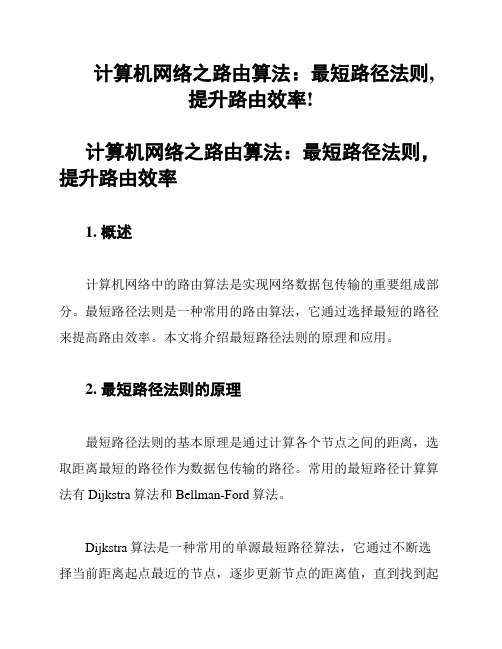
计算机网络之路由算法:最短路径法则,提升路由效率!计算机网络之路由算法:最短路径法则,提升路由效率1. 概述计算机网络中的路由算法是实现网络数据包传输的重要组成部分。
最短路径法则是一种常用的路由算法,它通过选择最短的路径来提高路由效率。
本文将介绍最短路径法则的原理和应用。
2. 最短路径法则的原理最短路径法则的基本原理是通过计算各个节点之间的距离,选取距离最短的路径作为数据包传输的路径。
常用的最短路径计算算法有Dijkstra算法和Bellman-Ford算法。
Dijkstra算法是一种常用的单源最短路径算法,它通过不断选择当前距离起点最近的节点,逐步更新节点的距离值,直到找到起点到目标节点的最短路径。
该算法的时间复杂度为O(V^2),其中V为网络中节点的数量。
Bellman-Ford算法是一种能够处理带有负权边的图的最短路径算法,它通过不断松弛边的权值来计算最短路径。
该算法的时间复杂度为O(VE),其中V为网络中节点的数量,E为网络中边的数量。
3. 最短路径法则的应用最短路径法则广泛应用于计算机网络中的路由选择和网络优化等方面。
通过选取最短路径,可以提高数据包传输的效率和速度,减少网络拥塞等问题。
在实际应用中,最短路径法则可以通过路由器和交换机等网络设备的配置来实现。
通过配置路由表和控制数据包的流向,可以实现数据包按照最短路径进行传输。
4. 总结最短路径法则是一种提高路由效率的常用算法,在计算机网络中具有广泛的应用。
通过选取最短路径,可以实现数据包的快速传输,并减少网络拥塞等问题。
不同的最短路径计算算法适用于不同的场景,选择适合的算法可以提升路由效率。
该文档提供了最短路径法则的概述、原理和应用,帮助读者理解和应用最短路径算法。
通过合理的路由算法选择和配置,可以优化网络性能,提高数据传输效率。
---*注意:本文档仅提供概述和基本原理,具体网络配置和算法细节需根据实际情况进行进一步研究和探索。
*。
最短路径-课件

欢迎来到最短路径算法的课程!在这个课件中,我们将探索什么是最短路径 算法以及它在不同情景中的应用。让我们开始吧!
什么是最短路径算法
最短路径算法是用于在图或网络中找到两个节点之间最短路径的计算方法。它在许多领域中都有广泛的 应用,例如网络路由、GPS导航和运筹学问题。
Dijkstra算法及其原理
在生产和物流中优化资源分配和路径选择, 以最大限度地提高效率。
最短路径算法的时间复杂度分 析
不同的最短路径算法具有不同的时间复杂度,了解它们的性能特点可以帮助 选择适合特定问题的算法。
最短路径算法在实际中的性能 优化
根据具体问题的特点,可以对最短路径算法进行各种优化,以加快计算速度 和减少资源消耗。
Floyd-Warshall算法及其原理
Floyd-Warshall算法是一种用于找到图中所有节点之间最短路径的算法。它通 过动态规划的方法计算节点之间的最短路径,并允许负权边的存在。
SPFA算法及其原理
SPFA(Shortest Path Faster Algorithm)算法是一种用于在加权图中找到单源最 短路径的算法 快的运行时间。
最短路径问题的应用
交通网络设计中的最短路径问题
帮助规划城市道路网络,以最小化交通拥堵 和行驶距离。
GPS导航中的最短路径问题
帮助导航系统计算出到达目标地点的最短路 径,以提供准确的导航指引。
网络路由问题中的最短路径问题
帮助选择网络中数据包的最佳路径,以最小 化传输时间和延迟。
运筹学中的最短路径问题
最短路径问题的分类
单源最短路径问题
寻找某个节点到其余所有节点的最短路径。
源点集合限制的最短路径问题
在一组源节点中寻找到达目标节点的最短路 径。
最短路径算法及应用

最短路径算法及应用最短路径算法通常基于图的表示,其中图由节点和边组成。
每个节点代表一个位置,每条边代表两个位置之间的连通关系。
每条边都有一个权重,表示该路径的长度、成本或时间等。
最短路径算法的目标是找到从起始节点到目标节点的最短路径,使得路径上所有边的权重之和最小。
最短路径算法有多种实现方法,包括迪杰斯特拉算法、贝尔曼-福特算法和A*算法等。
迪杰斯特拉算法是一种广泛使用的算法,它适用于无负权边的图。
该算法通过维护一个候选集合,逐步选择离起始节点最近的节点,并更新与其相邻节点的最短路径。
该过程重复直到找到到目标节点的最短路径。
另一种常见的最短路径算法是贝尔曼-福特算法,该算法适用于存在负权边的图。
它通过反复迭代图的所有边来不断更新每个节点的最短路径估计值。
该算法的一个特点是,它可以处理存在负权环的图,并且可以检测到这种情况。
A*算法是一种常用于路径规划的启发式算法。
它根据每个节点的预估成本(通常使用启发函数)来选择下一个要探索的节点。
该算法通过评估每个节点的实际距离加上启发式函数的估计距离,来选择最有希望导致最短路径的节点。
1.路径规划:最短路径算法可以被用于规划最短的路径,以避开交通拥堵,节约时间和成本。
2.交通网络优化:最短路径算法可以用于优化交通网络,找到使整个网络中车辆流量最小的路径。
3.通信网络路由:在通信网络中,最短路径算法可以被用于确定数据包传输的最短路径,以最大程度地减少延迟和拥塞。
4.GPS导航:GPS导航系统使用最短路径算法来计算最短和最快的路径,以引导驾驶员到目的地。
5.配送服务:在配送服务领域,最短路径算法可以被用于确定最佳的交付序列,以减少总运输时间和成本。
6.网页排名:在引擎中,最短路径算法可以被用于计算网页之间的关联程度,以确定网页的排名和结果排序。
总而言之,最短路径算法是图论中重要的算法之一,被广泛应用于各种领域。
通过找到最短路径,这些算法可以帮助我们节约时间、成本和资源,并优化各种系统的性能。
最短路径算法的原理和方法
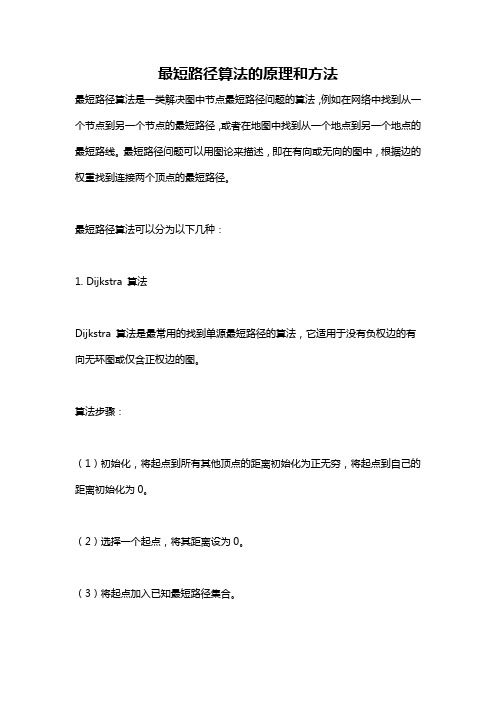
最短路径算法的原理和方法最短路径算法是一类解决图中节点最短路径问题的算法,例如在网络中找到从一个节点到另一个节点的最短路径,或者在地图中找到从一个地点到另一个地点的最短路线。
最短路径问题可以用图论来描述,即在有向或无向的图中,根据边的权重找到连接两个顶点的最短路径。
最短路径算法可以分为以下几种:1. Dijkstra 算法Dijkstra 算法是最常用的找到单源最短路径的算法,它适用于没有负权边的有向无环图或仅含正权边的图。
算法步骤:(1)初始化,将起点到所有其他顶点的距离初始化为正无穷,将起点到自己的距离初始化为0。
(2)选择一个起点,将其距离设为0。
(3)将起点加入已知最短路径集合。
(4)遍历与起点相邻的所有顶点,将它们到起点的距离更新为起点到它们的距离。
(5)从未加入已知最短路径集合中的顶点中选择最小距离的顶点,将它加入已知最短路径集合中。
(6)重复步骤4和步骤5直到所有顶点都被加入已知最短路径集合中。
2. Bellman-Ford 算法Bellman-Ford 算法是一种解决有负权边的单源最短路径问题的算法。
算法步骤:(1)初始化,将起点到所有其他顶点的距离初始化为正无穷,将起点到自己的距离初始化为0。
(2)遍历每条边,将该边起点的距离加上该边的权重,如果得到的距离比该边终点的距离小,则更新该终点的距离为该距离。
(3)重复步骤2 V-1 次,其中V 是图中的顶点数。
(4)检查是否存在负环,即在V-1 次迭代后,仍然可以更新顶点的距离。
如果存在负环,算法无法执行。
3. Floyd-Warshall 算法Floyd-Warshall 算法是一种解决所有顶点对之间的最短路径问题的算法。
算法步骤:(1)初始化,将每个顶点到其他顶点的距离初始化为边权,如果两个顶点之间没有边相连,则初始化为正无穷。
(2)依次加入每个顶点,如果通过加入该顶点可以得到更短的路径,则更新路径。
(3)输出结果,即每个顶点对之间的最短路径。
网络路由技术中的链路状态路由协议详解(系列七)
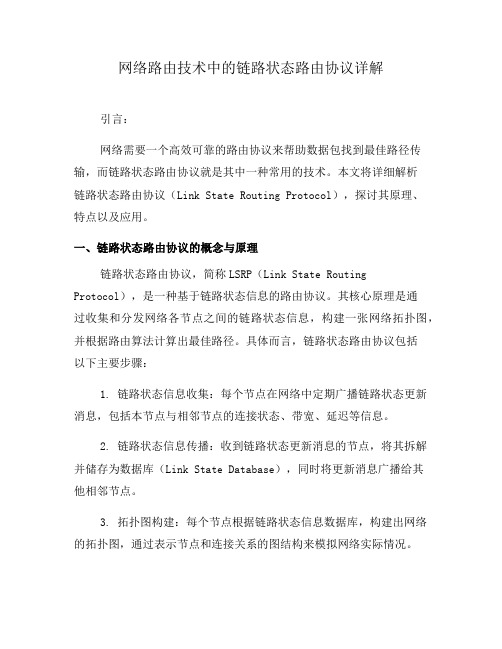
网络路由技术中的链路状态路由协议详解引言:网络需要一个高效可靠的路由协议来帮助数据包找到最佳路径传输,而链路状态路由协议就是其中一种常用的技术。
本文将详细解析链路状态路由协议(Link State Routing Protocol),探讨其原理、特点以及应用。
一、链路状态路由协议的概念与原理链路状态路由协议,简称LSRP(Link State Routing Protocol),是一种基于链路状态信息的路由协议。
其核心原理是通过收集和分发网络各节点之间的链路状态信息,构建一张网络拓扑图,并根据路由算法计算出最佳路径。
具体而言,链路状态路由协议包括以下主要步骤:1. 链路状态信息收集:每个节点在网络中定期广播链路状态更新消息,包括本节点与相邻节点的连接状态、带宽、延迟等信息。
2. 链路状态信息传播:收到链路状态更新消息的节点,将其拆解并储存为数据库(Link State Database),同时将更新消息广播给其他相邻节点。
3. 拓扑图构建:每个节点根据链路状态信息数据库,构建出网络的拓扑图,通过表示节点和连接关系的图结构来模拟网络实际情况。
4. 最短路径计算:基于构建的网络拓扑图,每个节点使用最短路径算法(如Dijkstra算法)计算到达目标节点的最佳路径。
5. 路由表生成:根据最短路径计算结果,每个节点生成路由表,记录到达其他节点的最佳路径和对应的下一跳节点。
二、链路状态路由协议的特点和优势链路状态路由协议具有以下几个特点和优势:1. 网络拓扑图准确性高:链路状态路由协议通过收集全网的链路状态信息,可以准确的构建出网络的拓扑图。
相对于其他路由协议,如距离向量路由协议,链路状态路由协议的网络拓扑图更加准确和可靠。
2. 路由计算效率高:通过最短路径算法,链路状态路由协议能够快速计算出最佳路径,并将其记录在路由表中。
由于链路状态信息数据库只需存储全局信息一次,而不是记录所有节点之间的距离,因此运算效率更高。
实验四-链路状态路由算法原理实验报告
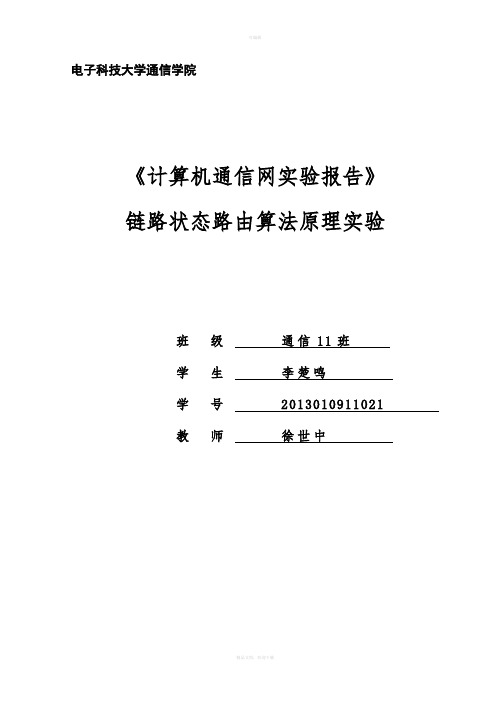
电子科技大学通信学院《计算机通信网实验报告》链路状态路由算法原理实验班级通信11班学生李楚鸣学号2013010911021教师徐世中实验4:链路状态路由算法原理实验报告【实验目的】1、要求实验者利用路由选择算法模拟软件提供的通信功能,模拟链路状态路由选择算法的初始化、路由信息扩散过程和路由计算方法;2、掌握链路状态算法的路由信息扩散过程;3、掌握链路状态算法的路由计算方法。
【实验环境】1、分组实验,每组4~10人。
2、拓扑:虚线表示节点之间的逻辑关系,构成一个逻辑上的网状拓扑结构。
3、设备:小组中每人一台计算机。
4、实验软件:路由选择算法模拟软件(routing.exe )【实验原理】(请根据实验指导书和课程相关只是填写,包括链路状态路由算法的基本原理,实验软件的基本功能等)【实验步骤】1、建立实验小组。
2、按照链路状态算法完成路由信息扩散和路由计算过程。
3、链路状态算法收敛后,向路由表中列出的每个非直连节点发送路由测试数据,完成路由测试过程。
4、汇总实验小组的实验记录信息,检查路由是否正确。
如果有错误,分析并发现错误产生的原因。
5、将实验从头多做几次,观察如果各节点发送信息和接收处理信息的过程不一样,是否会影响路由表的正确形成。
如在第一次实验时,节点接收一份路由信息后,路由节点N路由节点0路由节点2路由节点N-1局域网 (Ethernet )N = 4 ~ 10处理,再发送出新的路由信息,而第二次实验时,节点将当前所有的路由信息处理完后,才发送新的路由信息。
6、小组讨论将拓扑中的一条链路断掉,然后通过实验观察路由协议是如何适应这个变化的。
8、完成实验报告。
【实验记录】按照实验记录内容格式要求记录以下内容(不够请另附纸张):1、实验小组的建立要求记录:小组名称、成员数量、本节点编号、本地直连链路表和据此形成的路由表。
2、链路状态算法的路由扩散和路由计算过程要求记录:每次发送、接收的路由信息和根据接收信息所形成的路由表。
计算机网络的路由算法

计算机网络的路由算法在计算机网络中,路由算法是用来确定数据包从源节点到目标节点的路径的一种算法。
它是实现网络通信的重要组成部分,承担着决定数据传输路线的关键任务。
本文将介绍几种常见的路由算法。
一、最短路径算法最短路径算法是一种常见且重要的路由算法。
它的目标是找到节点之间的最短路径,以最快速度将数据包从源节点发送到目标节点。
其中,迪杰斯特拉算法和贝尔曼-福特算法是两种常见的最短路径算法。
迪杰斯特拉算法(Dijkstra Algorithm)是一种广泛应用于计算机网络中的最短路径算法。
它通过计算从源节点到其他节点的最短路径,并记录路径上的节点和距离,最终找到从源节点到目标节点的最短路径。
该算法具有高效性和准确性,很好地满足了网络数据传输的需求。
贝尔曼-福特算法(Bellman-Ford Algorithm)是另一种常用的最短路径算法。
与迪杰斯特拉算法不同的是,贝尔曼-福特算法可以处理包含负权边的图。
它通过迭代地更新节点之间的距离,直到收敛为止,找到最短路径。
虽然贝尔曼-福特算法的效率较低,但其对于具有复杂网络结构的情况仍然具有重要的应用价值。
二、最优路径算法除了最短路径算法,最优路径算法也是计算机网络中常用的路由算法之一。
最优路径算法旨在找到包括最少跳数、最小延迟或最大带宽等特定需求的路径,以满足网络通信的性能要求。
例如,最小跳数算法(Minimum Hop Routing)是一种常见的最优路径算法,它通过选择路径上的最少跳数来实现数据传输。
这在实时性要求较高的应用场景中非常有用,如语音通话和视频会议等。
另外,最小延迟算法(Minimum Delay Routing)和最大带宽算法(Maximum Bandwidth Routing)也是常用的最优路径算法。
前者通过选择具有最小传输延迟的路径来实现数据传输,适用于对实时性要求较高的应用。
而后者则通过选择具有最大传输带宽的路径来实现数据传输,适用于对吞吐量要求较高的应用。
图论中的最短路径算法

图论是离散数学中的一个分支,研究的是图及其性质。
其中最短路径算法是图论中的一个重要内容,用于寻找图中两个节点之间最短路径的方法。
最短路径算法在很多实际问题中都有应用,比如电信网络中的路由选择、交通运输中的路线规划、地理信息系统中的路径查询等。
在这些应用中,我们需要找到一条连接两个节点之间距离最短的路径,以实现高效的数据传输、交通规划和路径导航等功能。
在最短路径算法中,最经典且常用的算法之一是迪杰斯特拉算法(Dijkstra's algorithm)。
迪杰斯特拉算法基于图的搜索和贪心算法的思想,通过动态规划的方式逐步确定到达每个节点的最短路径。
算法的基本思路如下:1.创建两个集合:一个用于保存已经确定最短路径的节点集合S,一个用于保存未确定最短路径的节点集合Q。
2.将起始节点放入集合S,将其余节点放入集合Q,并标记初始距离为无穷大。
3.初始化起始节点的距离为0。
4.在集合Q中选择一个节点v,该节点的距离最小。
5.对节点v的所有邻居节点w,更新其距离:若从起始节点出发,经过节点v到达节点w的距离小于已经记录的最短距离,则更新最短距离。
6.重复步骤4和5,直到集合Q为空集。
迪杰斯特拉算法的基本原理是不断选择离起始节点距离最近的节点,并通过比较当前最短距离和新的路径长度,来更新最短距离。
算法的优势在于效率高,但仅适用于无负权边的图。
除了迪杰斯特拉算法,另一个常用的最短路径算法是弗洛伊德算法(Floyd-Warshall algorithm)。
弗洛伊德算法基于动态规划的思想,通过逐步更新两个节点之间的最短距离矩阵来求解最短路径。
算法的基本步骤如下:1.创建一个二维数组D,用于保存两个节点之间的最短距离。
初始时,若两个节点之间有边,则将距离保存为边的权值,若没有边,则将距离设置为无穷大。
2.对于每对节点i和j,更新它们之间的最短距离:若存在节点k使得从i到k再到j的路径距离小于直接从i到j的路径距离,则更新最短距离。
最短路径路由算法

最短路径路由算法
最短路径路由算法是网络中常用的一种路由算法,它的目的是找到从源节点到目标节点最短的路径,并将数据沿着这条路径发送。
最短路径路由算法有多种实现方式,其中最经典的是Dijkstra算法和Bellman-Ford算法。
Dijkstra算法的基本思想是以源节点为起点,不断寻找距离源节点最近的未访问过的节点,直到找到目标节点或者所有节点都被访问完为止。
在每次寻找最近节点的过程中,需要更新该节点到起点的距离和路径信息。
Dijkstra算法的时间复杂度为O(N^2),其中N为节点数。
Bellman-Ford算法则是通过松弛操作来不断更新节点的距离信息,从而得到最短路径。
松弛操作的定义为:对于一条边(u, v),如果存在更短的路径u->w->v,则将节点v的距离信息更新为u->w->v 的距离。
Bellman-Ford算法的时间复杂度为O(N*M),其中M为边数。
除了Dijkstra算法和Bellman-Ford算法,还有很多其他的最短路径路由算法,如A*算法、SPFA算法等。
这些算法的核心思想都是在原有的最短路径算法基础上进行了改进,以适应不同的网络环境和应用场景。
最短路径路由算法在实际应用中具有广泛的价值。
例如,在互联网中,路由器需要根据目的地址选择最优的路径将数据包发送到目标节点;在城市交通管理中,需要根据交通拥堵情况和交通规划选择最短路径来优化车辆行驶路线;在金融行业中,需要根据货币汇率和资
金流动情况来确定最优的资金流转路径等等。
因此,最短路径路由算法的研究和应用具有非常广泛的实际意义。
postgresql+postgis+pgrouting实现最短路径查询(1)---线数据。。。
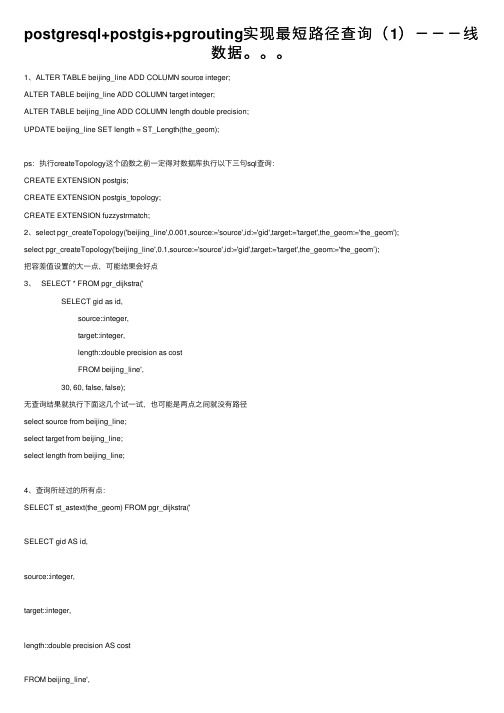
postgresql+postgis+pgrouting实现最短路径查询(1)---线数据。
1、ALTER TABLE beijing_line ADD COLUMN source integer;ALTER TABLE beijing_line ADD COLUMN target integer;ALTER TABLE beijing_line ADD COLUMN length double precision;UPDATE beijing_line SET length = ST_Length(the_geom);ps:执⾏createTopology这个函数之前⼀定得对数据库执⾏以下三句sql查询:CREATE EXTENSION postgis;CREATE EXTENSION postgis_topology;CREATE EXTENSION fuzzystrmatch;2、select pgr_createTopology('beijing_line',0.001,source:='source',id:='gid',target:='target',the_geom:='the_geom');select pgr_createTopology('beijing_line',0.1,source:='source',id:='gid',target:='target',the_geom:='the_geom’);把容差值设置的⼤⼀点,可能结果会好点3、 SELECT * FROM pgr_dijkstra('SELECT gid as id,source::integer,target::integer,length::double precision as costFROM beijing_line',30, 60, false, false);⽆查询结果就执⾏下⾯这⼏个试⼀试,也可能是两点之间就没有路径select source from beijing_line;select target from beijing_line;select length from beijing_line;4、查询所经过的所有点:SELECT st_astext(the_geom) FROM pgr_dijkstra('SELECT gid AS id,source::integer,target::integer,length::double precision AS costFROM beijing_line',30, 60, false, false) as dijoin beijing_line pton di.id2 = pt.gid;5、将路径写⼊⼀个⼏何⽂件内:SELECT seq, id1 AS node, id2 AS edge, cost,the_geom into dijkstra_res FROM pgr_dijkstra('SELECT gid AS id,source::integer,target::integer,length::double precision AS costFROM beijing_line',30, 60, false, false) as dijoin beijing_line pton di.id2 = pt.gid;经历过以上的步骤,如果⼀切顺利,应该能看到结果,这⾥不再截图。
【初中数学】最短路径模型及例题解析
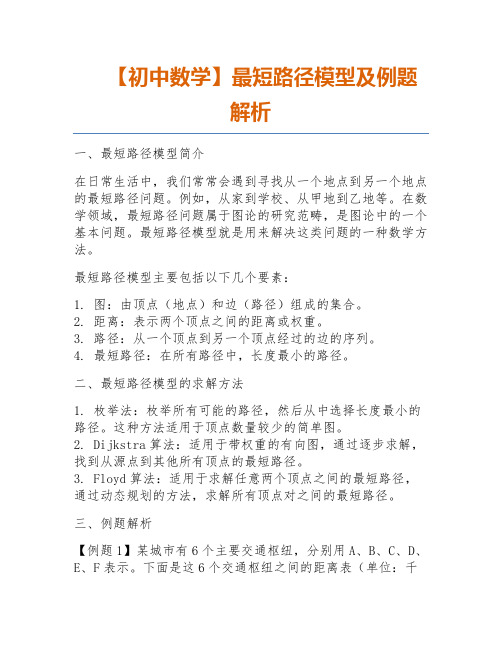
【初中数学】最短路径模型及例题解析一、最短路径模型简介在日常生活中,我们常常会遇到寻找从一个地点到另一个地点的最短路径问题。
例如,从家到学校、从甲地到乙地等。
在数学领域,最短路径问题属于图论的研究范畴,是图论中的一个基本问题。
最短路径模型就是用来解决这类问题的一种数学方法。
最短路径模型主要包括以下几个要素:1. 图:由顶点(地点)和边(路径)组成的集合。
2. 距离:表示两个顶点之间的距离或权重。
3. 路径:从一个顶点到另一个顶点经过的边的序列。
4. 最短路径:在所有路径中,长度最小的路径。
二、最短路径模型的求解方法1. 枚举法:枚举所有可能的路径,然后从中选择长度最小的路径。
这种方法适用于顶点数量较少的简单图。
2. Dijkstra算法:适用于带权重的有向图,通过逐步求解,找到从源点到其他所有顶点的最短路径。
3. Floyd算法:适用于求解任意两个顶点之间的最短路径,通过动态规划的方法,求解所有顶点对之间的最短路径。
三、例题解析【例题1】某城市有6个主要交通枢纽,分别用A、B、C、D、E、F表示。
下面是这6个交通枢纽之间的距离表(单位:千米):```A B C D E FA 0 5 7 8 9 10B 5 0 6 7 8 9C 7 6 0 4 5 6D 8 7 4 0 3 4E 9 8 5 3 0 2F 10 9 6 4 2 0```求从A到F的最短路径。
【解析】这是一个典型的最短路径问题,我们可以使用Dijkstra算法求解。
1. 初始化:将所有顶点的距离设置为无穷大,源点A的距离设置为0。
2. 选取距离最小的顶点,标记为已访问。
此时,A为已访问顶点。
3. 更新相邻顶点的距离:从A出发,更新B、C、D、E、F的距离。
此时,B、C、D、E、F的距离分别为5、7、8、9、10。
4. 重复步骤2和3,直到所有顶点都被访问。
最后得到的最短路径为A→B→E→F,长度为14千米。
【例题2】某城市有5个公园,分别用P1、P2、P3、P4、P5表示。
物流配送网络优化分析及最短路径算法
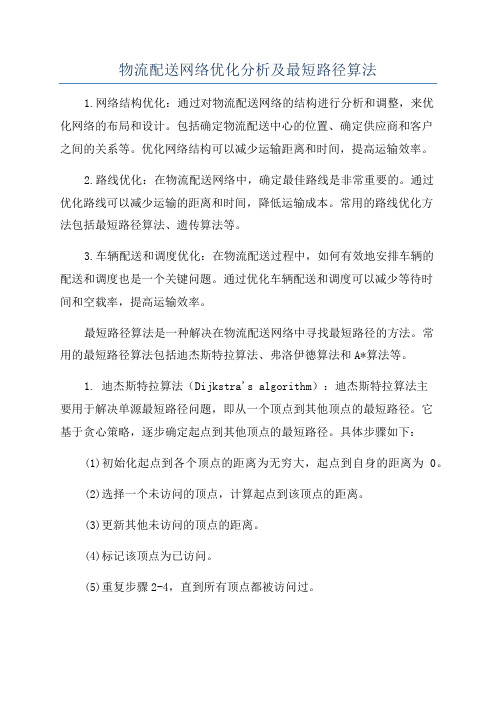
物流配送网络优化分析及最短路径算法1.网络结构优化:通过对物流配送网络的结构进行分析和调整,来优化网络的布局和设计。
包括确定物流配送中心的位置、确定供应商和客户之间的关系等。
优化网络结构可以减少运输距离和时间,提高运输效率。
2.路线优化:在物流配送网络中,确定最佳路线是非常重要的。
通过优化路线可以减少运输的距离和时间,降低运输成本。
常用的路线优化方法包括最短路径算法、遗传算法等。
3.车辆配送和调度优化:在物流配送过程中,如何有效地安排车辆的配送和调度也是一个关键问题。
通过优化车辆配送和调度可以减少等待时间和空载率,提高运输效率。
最短路径算法是一种解决在物流配送网络中寻找最短路径的方法。
常用的最短路径算法包括迪杰斯特拉算法、弗洛伊德算法和A*算法等。
1. 迪杰斯特拉算法(Dijkstra's algorithm):迪杰斯特拉算法主要用于解决单源最短路径问题,即从一个顶点到其他顶点的最短路径。
它基于贪心策略,逐步确定起点到其他顶点的最短路径。
具体步骤如下:(1)初始化起点到各个顶点的距离为无穷大,起点到自身的距离为0。
(2)选择一个未访问的顶点,计算起点到该顶点的距离。
(3)更新其他未访问的顶点的距离。
(4)标记该顶点为已访问。
(5)重复步骤2-4,直到所有顶点都被访问过。
2. 弗洛伊德算法(Floyd-Warshall algorithm):弗洛伊德算法可以解决任意两点之间的最短路径。
该算法使用动态规划的思想,通过逐步迭代来更新路径的长度。
具体步骤如下:(1)初始化各个顶点之间的路径长度。
(2)逐步迭代更新路径长度,直到找到最短路径。
3. A*算法(A-star algorithm):A*算法是一种基于启发式的最短路径算法。
该算法通过引入启发函数来评估当前节点到目标节点的代价,然后选择代价最小的节点进行扩展。
具体步骤如下:(1)初始化起点节点和终点节点。
(2)根据启发函数评估每个节点的优先级。
最短路径算法介绍

最短路径算法介绍最短路径算法是计算两个节点之间最短路径的一组算法。
在计算网络最短路径、交通路线规划、导航系统以及优化其他经济和工业流程等很多领域都有广泛的应用。
最短路径算法的目标是找出网络中连接起始节点与目标节点的最短路径。
在网络中,起始节点和目标节点被称为源节点和目标节点。
网络包含节点(也称为顶点)和连接节点的边。
每一条边上都有一个权重,这个权重表示了通过这条边所需要的代价或距离等值。
最短路径算法是通过这些权重来查找最短路径的。
最短路径算法的核心思想是通过规定一些规则或算法来查找网络上的最短路径。
最常用的最短路径算法是Dijkstra算法和A*算法。
Dijkstra算法是一个基于贪心算法的最短路径算法,它的特点是时间复杂度较低,适用于稠密图。
而A*算法是通过启发式搜索来计算最短路径的,它适用于稀疏图和高维空间搜索(如机器人路径规划)。
Dijkstra算法的基本思想是从源节点开始依次计算到各个节点的最短距离,直到计算出目标节点的最短路径。
Dijkstra算法的优点是保证了每个节点被计算后,所有可能的最短路径都被计算过,从而保证了最终计算出的路径是最短路径。
Dijkstra算法的缺点是需要存储所有节点的距离,因此对于大规模图,存储距离的开销非常大。
A*算法是一种启发式搜索算法。
它是在Dijkstra算法的基础上引入了启发式函数,利用这个函数来评估节点到目标节点的距离,从而优先扩展距离目标节点更近的节点。
A*算法的重点是设计合适的启发函数,这个函数应该尽可能地准确地评估节点到目标节点的距离。
与Dijkstra算法相比,A*算法可以大大减少计算开销,从而提高算法的效率。
最短路径算法在实际的应用中非常重要。
在网络最短路径问题中,最短路径算法可以用于计算网络拓扑的特征,如网络直径、网络中心性等。
在地图导航和交通规划中,最短路径算法可以用于找到最短的路径以及计算交通拥堵等。
在机器人路径规划中,最短路径算法可以用于确定机器人行走的最短路径以及防止机器人撞到障碍物等。
最短路径算法与应用中的问题分析(史上最全路径算法总结)

二,任意权值的单源最短路径算法,解决上述问题 2.
1, 问题的描述: 给定一个有向带权图 D 与源点 v,各边上的权值为任意实数,要求找出从 v 出 发到 D 中其它各顶点的最短路径。 2, 算法的主要思想: 此种情况下我们可以用 Bellman-ford 算法。 当图中没有由带负权值的边组成的回 路时,有 n 个顶点的图中任意两个顶点之间如果存在最短路径,此路径最多有 n-1 条边。 Bellman-Ford 方法构造一个最短路径长度数组序列 dist1[u], dist2[u], …, distn-1[u],其中,dist n-1[u]是从源点 v 出发最多经过不构成带负长度边回路的 n-1 条边到达终点 u 的最短路径长度。算法的最终目的是计算出 dist
六,如果权值非负,求其总长最短的一条过全部节点的初级回路。解 决问题 7。
1,问题的描述: 给定一个正权完全图, 求其总长最短的哈密顿回路。 所谓的哈密顿回路便是无向 图中一条经过全部节点的初级回路。这个便是图论中非常经典的旅行商问题。 2,算法的主要思想: 解决旅行商问题的一种比较精确的求解方法是分支与界法。 分支与界法的基本思路是: 1, 首先将边权由小到大排序,初始界 d0 。 2, 在边权序列中依次选边进行深探,直到选取 n 条边,判断是否构成 H 回路, 若是, d0 d (s1) ,结束。 3, 继续深探, 依次删除当前 si 中的最长边, 加入后面第一条待选边, 进行深探, 如果它是 H 回路且 d( si ) d 0 ,则 d0 d ( si ) 作为界。 4, 退栈过程,不能再深探时需要退栈。如果栈空,结束,其最佳值为 d0。否则 如果新分支的 d( si ) d 0 ,继续退栈;若 d(si)<d0,转 3. 这种搜索过程是在不断的构造分支与确定界值。一旦确定了界值,则对大于等于 界值的分支不在搜索, 而且最后得到的界值就是问题的最佳解。但是在最坏的情 况下,该算法的时间复杂度是 O(n!)。因此在实际问题中,我们经常采用近似算 法求解问题的近似最优解,近似算法中比较好的是“便宜”算法。 便宜算法的基本思路: 初始化时 T=(1,1); S ={2,3, · · · ,n} T 是一个不断扩充的初级回路,最初是一个自环。首先我们选取 S 中与 T 距离最 近的节点 j。设(j,t)是相应的边,这时节点 j 或插入到回路 T 中 t 的前面或者 插入到其后面,这根据 j 插入后回路 T 长度增量的大小而定。即如果 ,则插入到 t 与 t1 之间,否则 w ( j ,t ) w ( j ,t 1) w( t ,t 1) w (j t , ) w (j t , 2 ) w t ( t, 2 ) 插入在 t 与 t2 之间。
- 1、下载文档前请自行甄别文档内容的完整性,平台不提供额外的编辑、内容补充、找答案等附加服务。
- 2、"仅部分预览"的文档,不可在线预览部分如存在完整性等问题,可反馈申请退款(可完整预览的文档不适用该条件!)。
- 3、如文档侵犯您的权益,请联系客服反馈,我们会尽快为您处理(人工客服工作时间:9:00-18:30)。
STUDENT ID: 2012210547 NAME: 陈 玲
Routing--Shortest-Path Algorithms Routing
Routing is the process of selecting best paths in a network. In the past, the term routing was also used to mean forwarding network traffic among networks. However this latter function is much better described as simply forwarding. Routing is performed for many kinds of networks, including the telephone network (circuit switching), electronic data networks (such as the Internet), and transportation networks. In packet switching network One of the most complex and crucial design aspects of switched data networks is routing. The routing function attempts to find the least-cost route through the network, with cost based on number of hops, expected delay, or other metrics. Adaptive routing algorithms typically rely on the exchange of information about traffic conditions among nodes. The following picture is an example of network configuration:
Routing Strategies
A large number of routing strategies have evolved for dealing with the routing requirements of packet-switching networks. Next, I’ll make a brief introduction of the following four key strategies: fixed, flooding, random, and adaptive. Fixed Routing For fixed routing, a single, permanent route is configured for each source-destination pair of nodes in the network. Either of the least-cost routing algorithms could be used. The routes are fixed, or at least only change when there is a change in the topology of the network. Thus, the link costs used in designing routes cannot be based on any dynamic variable such as traffic.
Page 3 of 7
NETWORK SWITCHING AND ROUTING HOMEWORK
Disadvantages: • The routing decision is more complex; • The tradeoff between the quality of the information and the amount of overhead. • An adaptive strategy may react too quickly, causing congestion-producing oscillation, or too slowly, being irrelevant. Advantages: • An adaptive routing strategy can improve performance, as seen by the network user. • An adaptive routing strategy can aid in congestion control. Because an adaptive routing strategy tends to balance loads, it can delay the onset of severe congestion..
Shortest-Path Algorithms
Virtually all packet-switching networks and all internets base their routing decision on some form of least-cost criterion. If the criterion is to minimize the number of hops, each link has a value of 1. More typically, the link value is inversely proportional to the link capacity, proportional to the current load on the link, or some combination. Given a network of nodes connected by bidirectional links, where each link has a cost associated with it in each direction, define the cost of a path between two nodes as the sum of the costs of the links traversed. For each pair of nodes, find a path with the least cost. Dijkstra’s Algorithm Dijkstra’s algorithm can be stated as: Find the shortest paths from a given source node to all other
Page 2 of 7
NETWORK SWITCHING AND ROUTING HOMEWORK
Random Routing Random routing has the simplicity and robustness of flooding with far less traffic load. With random routing, a node selects only one outgoing path for retransmission of an incoming packet. The selection of outgoing link can be random and round-robin. A refinement of this technique is to assign a probability to each outgoing link and to select the link based on that probability. Like flooding, random routing requires the use of no network information. Because the route taken is random, the actual route will typically not be the least-cost route nor the minimum-hop route. Adaptive Routing In virtually all packet-switching networks, some sort of adaptive routing technique is used.That is, the routing decisions that are made change as conditions on the network change due to failure or congestion. For adaptive routing to be possible, information about the state of the network must be exchanged among the nodes. The following picture is one example of adaptive routingWORK SWITCHING AND ROUTING HOMEWORK
The following picture suggests how fixed routing might be implemented.
Flooding This technique requires no network information whatsoever and works as follows. A packet is sent by a source node to every one of its neighbors. At each node, an incoming packet is retransmitted on all outgoing links except for the link on which it arrived. Each packet should have unique identifiers so that duplicates can be discarded. There’s some ways to limit the incessant retransmission.One way to prevent this is for each node to remember the identity of those packets it has already retransmitted. And the other way is to include a hop count field with each packet. Three remarkable properties: • All possible routes between source and destination are tried. • At least one copy of the packet to arrive at the destination will have used a minimum-hop route. • All nodes that are directly or indirectly connected to the source node are visited. The following picture is one example of flooding:
